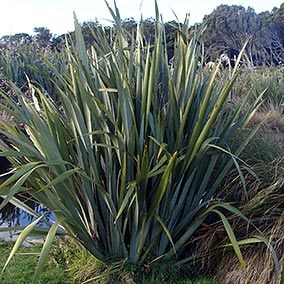The shrubland plants described below are the same as those planted to restore a forest as this type of shrubland is actually a successional forest stage. The process of re-colonising a bare patch of land is called ‘succession’. It takes many years for the process of succession to transform an area from bare land to mature forest
During the succession process each group of plants makes the site suitable for the next group of plants, but no longer suitable for themselves. These plants are called ‘colonising’ or ‘nursery’ plants. They are eventually replaced until mature canopy trees establish. Find out more about colonising species and How Forests Work.
Native ‘colonizing’ species are tough and though every site is different, our experience shows that by using a small range of Southland species you will have most success.
Recommended plants

Black Mapou / Kohuhu (Pittosporum tenufolium)
- Height: Up to 10 metres.
- Form: Shrub or small slender tree.
- Bark: Dark grey-black, smooth.
- Leaves: Light green, oblong with wavy edges with white mid vein.
- Flowers: Small, dark red flowers that occur singly and are sweet scented at night.
- Fruit: Capsules with black sticky seeds.

Broadleaf / Papauma (Griselinia littoralis)
- Height: Up to 15 metres.
- Form: Small tree.
- Bark: Grey, furrowed.
- Leaves: Thick, shiny, yellow-green with rounded apex.
- Flowers: Small, green, in clusters, male and female on separate plants.
- Fruit: Blue/black berries.

Cabbage Tree / Ti kouka (Cordyline australis)
- Height: Up to 20 metres.
- Form: Distinctive palm-like tree, unbranched trunk in young tree and branching in the upper half of older trees.
- Bark: Grey, thick, corky and rough.
- Leaves: Mass of long leaves (up to 1m) at the end of stems.
- Flowers: Small, sweet scented, white, in panicles up to 1m long.
- Fruit: Whitish berries becoming dry.

Flax / Harakeke (Phormium tenax)
- Height: 1-3 metres.
- Form: Robust, fan-like clumps of leaves.
- Leaves: Long and fibrous.
- Flowers: Stalk, 3-5m tall, reddish or orange-yellow flowers.
- Fruit: Dark seed capsule with glossy black seeds – upright pod.

Koromiko (Hebe salicifolia)
- Height: Up to 5 metres.
- Form: Bright green leafy shrub.
- Leaves: Bright green, long, thin, willow-like.
- Flowers: White, clustered in spikes.
- Fruit: Small dry brown capsules containing tiny seeds.

Lemonwood / Tarata (Pittosporum eugenioides)
- Height: Up to 12 metres.
- Form: Small tree – juvenile compact and mature tree more open.
- Bark: Grey-brown, smooth in the juvenile and rough in the adult.
- Leaves: Light green glossy, wavy, with pale midvein, lemony smell when crushed.
- Flowers: Sweet-scented yellow to cream flowers, in large clusters.
- Fruit: Capsules with black sticky seeds when mature.

Manuka (Leptospermum scoparium)
- Height: Up to 8 metres.
- Form: Large shrub or small tree.
- Bark: Stringy grey-brown bark, peels off in long strips.
- Leaves: Small, prickly to touch.
- Flowers: Masses of white flowers.
- Fruit: Characteristic woody seed capsules.

Mingimingi (Coprosma propinqua)
- Height: Up to 5 metres.
- Form: Bushy tangled dark shrub.
- Bark: Grey.
- Leaves: Small, dark green, thick, paler underneath.
- Flowers: Solitary or in clusters, male and female on separate plants.
- Fruit: Translucent blue, flecked with darker blue.

Narrow-leaved mahoe / Mahoe-wao (Melicytus lanceolatus)
- Height: Up to 5 metres.
- Form: Shrub or small bushy tree.
- Bark: Grey and spotty.
- Leaves: Bright green, long, serrated, lance-like.
- Flowers: Small, yellow or purplish.
- Fruit: Dark purple berries.

Ribbonwood / Manatu (Plagianthus regius)
- Height: Up to 17 metres.
- Form: Deciduous tree with interlaced branched juvenile form.
- Bark: Clean trunks with lacy bark.
- Leaves: Pale green, toothed, soft, deciduous.
- Flowers: Yellowish-green, tiny, in clusters, male and female on separate plants.
- Fruit: Downy seed capsules.
